Environmental Management for Sustainable Development: Part A & B
VerifiedAdded on 2021/09/29
|28
|7166
|68
Report
AI Summary
This report delves into the critical aspects of environmental management for sustainable development, encompassing a range of interconnected topics. It begins by defining the Anthropocene and its implications, then explores intrinsic and instrumental environmental values. The report further examines the commodification of nature, the concept of planetary urbanism, and the role of cities in shaping the environment. It also analyzes historical events like the Columbian Exchange and the evolution of conservation efforts, including the New South Wales Game Protection Act. The report contrasts the philosophies of John Muir and Gifford Pinchot on conservation and concludes by discussing the significance of the year 1788 in relation to environmental management. This comprehensive analysis provides insights into the complex relationship between human activities and the environment, emphasizing the importance of sustainable practices.
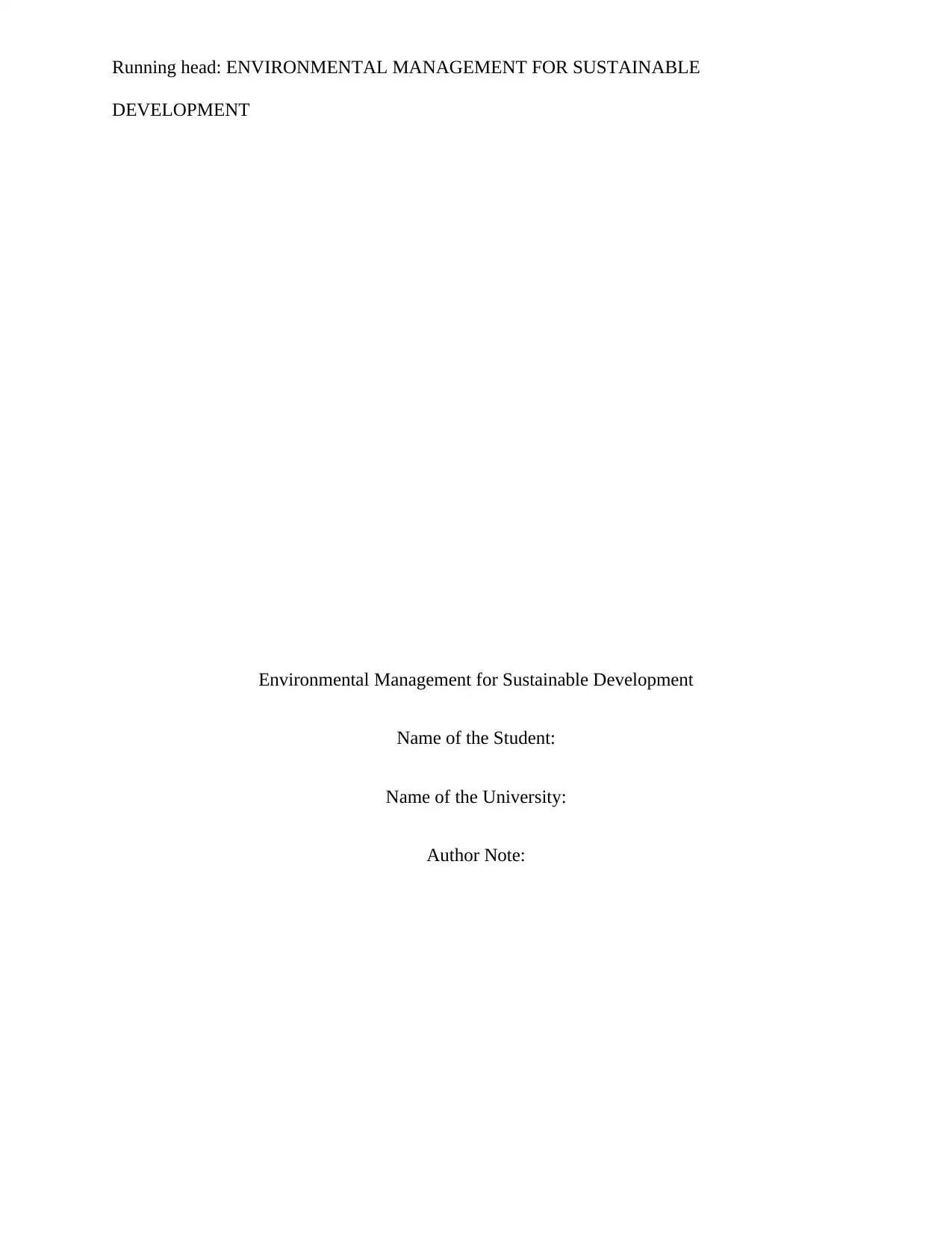
Running head: ENVIRONMENTAL MANAGEMENT FOR SUSTAINABLE
DEVELOPMENT
Environmental Management for Sustainable Development
Name of the Student:
Name of the University:
Author Note:
DEVELOPMENT
Environmental Management for Sustainable Development
Name of the Student:
Name of the University:
Author Note:
Paraphrase This Document
Need a fresh take? Get an instant paraphrase of this document with our AI Paraphraser
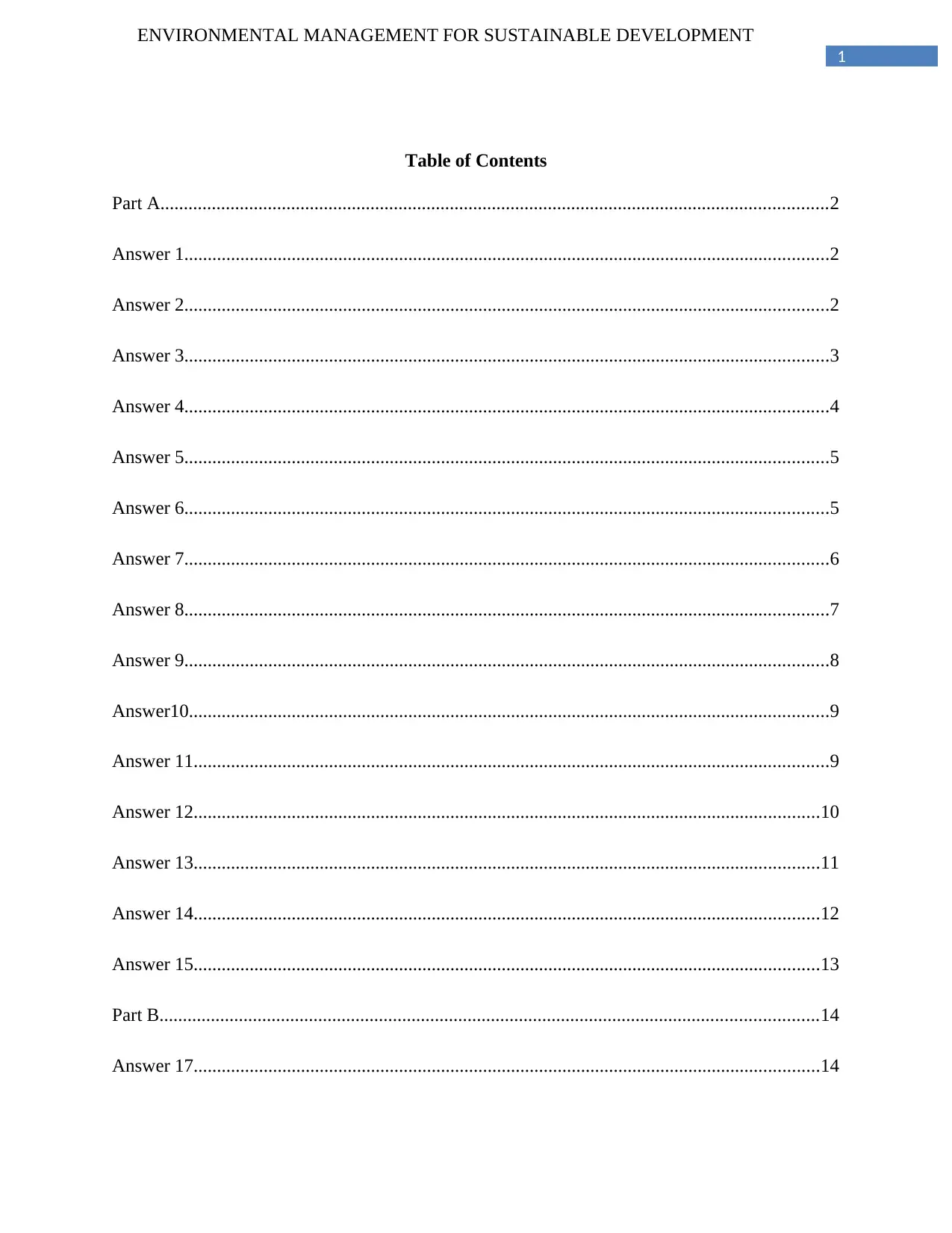
1
ENVIRONMENTAL MANAGEMENT FOR SUSTAINABLE DEVELOPMENT
Table of Contents
Part A...............................................................................................................................................2
Answer 1..........................................................................................................................................2
Answer 2..........................................................................................................................................2
Answer 3..........................................................................................................................................3
Answer 4..........................................................................................................................................4
Answer 5..........................................................................................................................................5
Answer 6..........................................................................................................................................5
Answer 7..........................................................................................................................................6
Answer 8..........................................................................................................................................7
Answer 9..........................................................................................................................................8
Answer10.........................................................................................................................................9
Answer 11........................................................................................................................................9
Answer 12......................................................................................................................................10
Answer 13......................................................................................................................................11
Answer 14......................................................................................................................................12
Answer 15......................................................................................................................................13
Part B.............................................................................................................................................14
Answer 17......................................................................................................................................14
ENVIRONMENTAL MANAGEMENT FOR SUSTAINABLE DEVELOPMENT
Table of Contents
Part A...............................................................................................................................................2
Answer 1..........................................................................................................................................2
Answer 2..........................................................................................................................................2
Answer 3..........................................................................................................................................3
Answer 4..........................................................................................................................................4
Answer 5..........................................................................................................................................5
Answer 6..........................................................................................................................................5
Answer 7..........................................................................................................................................6
Answer 8..........................................................................................................................................7
Answer 9..........................................................................................................................................8
Answer10.........................................................................................................................................9
Answer 11........................................................................................................................................9
Answer 12......................................................................................................................................10
Answer 13......................................................................................................................................11
Answer 14......................................................................................................................................12
Answer 15......................................................................................................................................13
Part B.............................................................................................................................................14
Answer 17......................................................................................................................................14
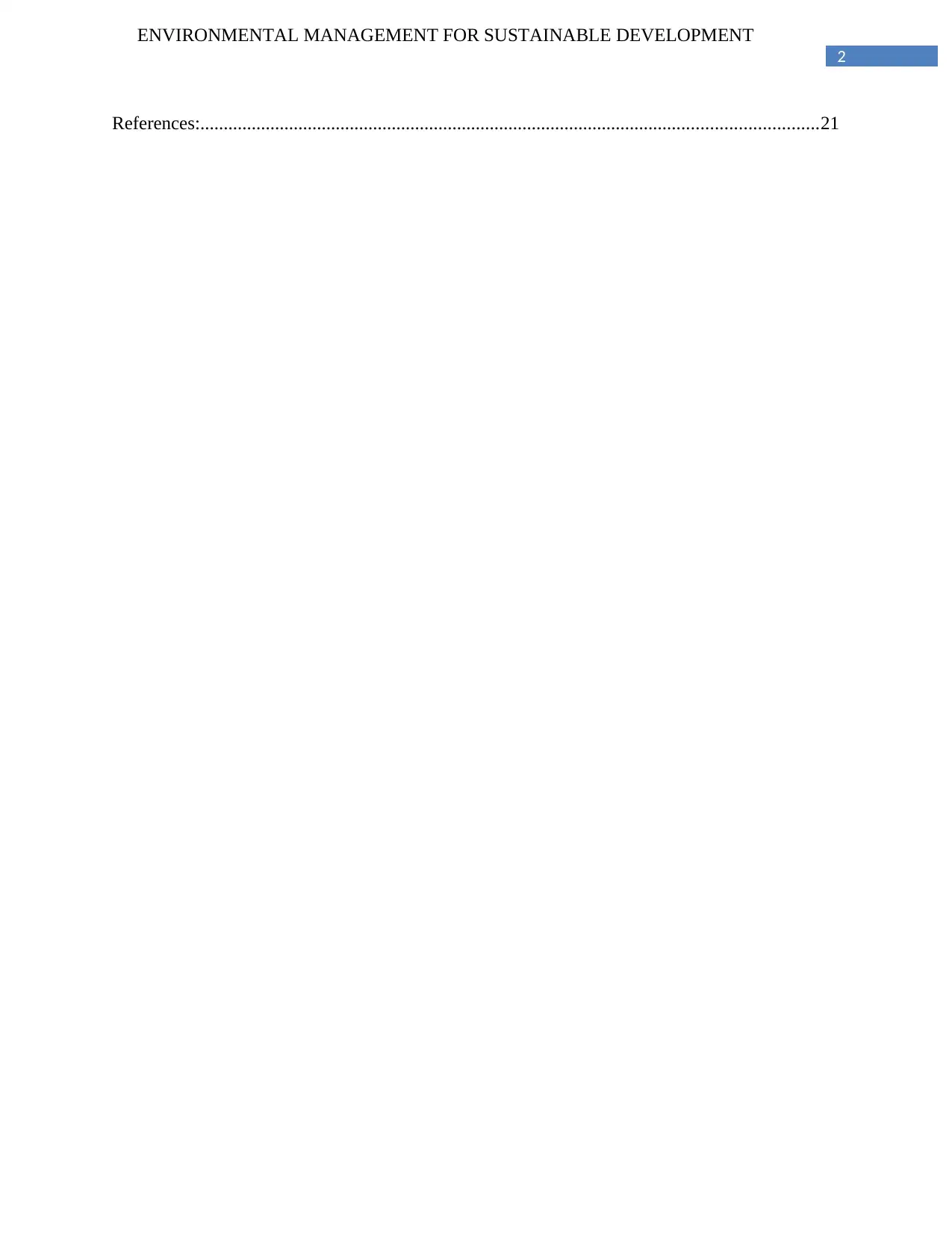
2
ENVIRONMENTAL MANAGEMENT FOR SUSTAINABLE DEVELOPMENT
References:....................................................................................................................................21
ENVIRONMENTAL MANAGEMENT FOR SUSTAINABLE DEVELOPMENT
References:....................................................................................................................................21
⊘ This is a preview!⊘
Do you want full access?
Subscribe today to unlock all pages.

Trusted by 1+ million students worldwide
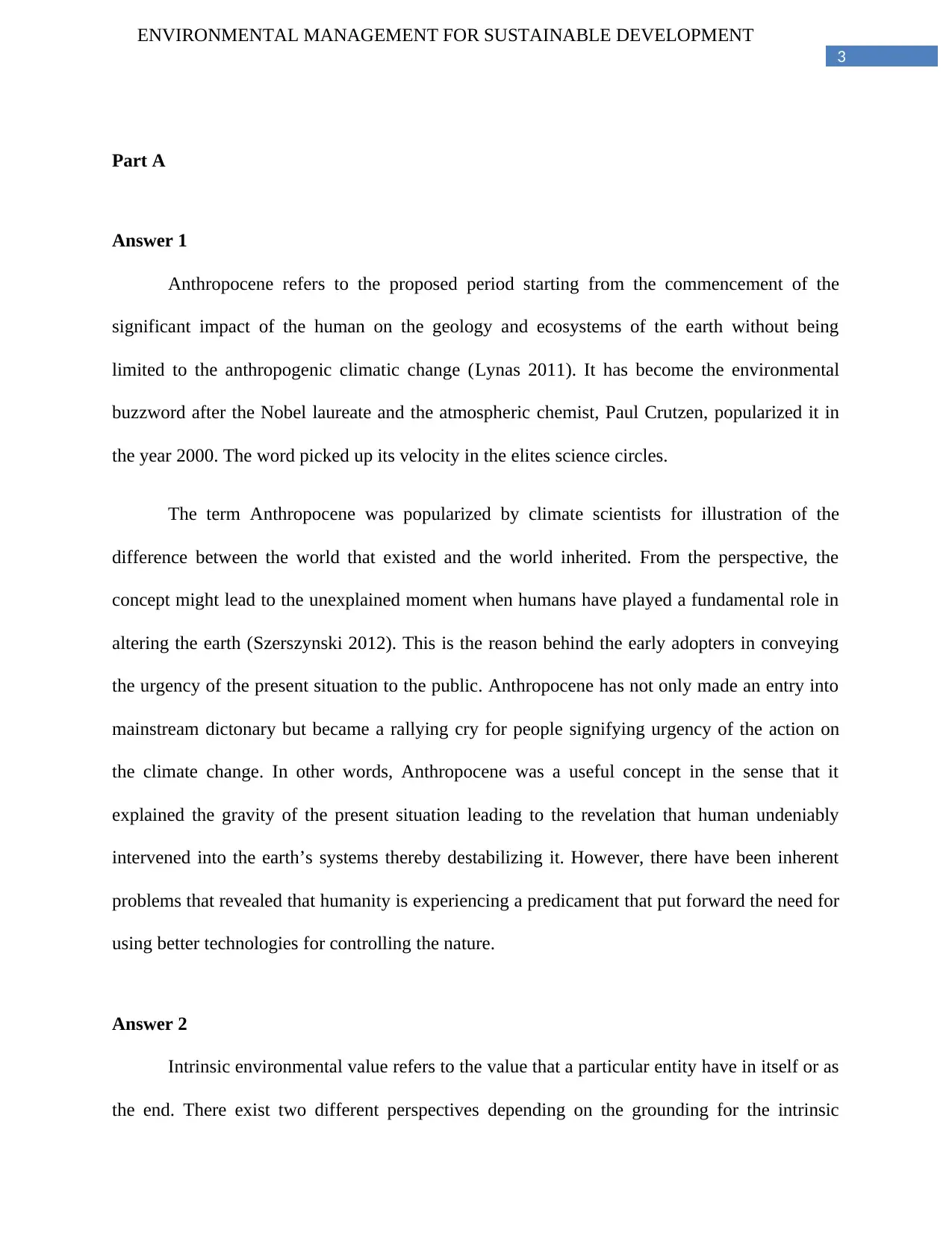
3
ENVIRONMENTAL MANAGEMENT FOR SUSTAINABLE DEVELOPMENT
Part A
Answer 1
Anthropocene refers to the proposed period starting from the commencement of the
significant impact of the human on the geology and ecosystems of the earth without being
limited to the anthropogenic climatic change (Lynas 2011). It has become the environmental
buzzword after the Nobel laureate and the atmospheric chemist, Paul Crutzen, popularized it in
the year 2000. The word picked up its velocity in the elites science circles.
The term Anthropocene was popularized by climate scientists for illustration of the
difference between the world that existed and the world inherited. From the perspective, the
concept might lead to the unexplained moment when humans have played a fundamental role in
altering the earth (Szerszynski 2012). This is the reason behind the early adopters in conveying
the urgency of the present situation to the public. Anthropocene has not only made an entry into
mainstream dictonary but became a rallying cry for people signifying urgency of the action on
the climate change. In other words, Anthropocene was a useful concept in the sense that it
explained the gravity of the present situation leading to the revelation that human undeniably
intervened into the earth’s systems thereby destabilizing it. However, there have been inherent
problems that revealed that humanity is experiencing a predicament that put forward the need for
using better technologies for controlling the nature.
Answer 2
Intrinsic environmental value refers to the value that a particular entity have in itself or as
the end. There exist two different perspectives depending on the grounding for the intrinsic
ENVIRONMENTAL MANAGEMENT FOR SUSTAINABLE DEVELOPMENT
Part A
Answer 1
Anthropocene refers to the proposed period starting from the commencement of the
significant impact of the human on the geology and ecosystems of the earth without being
limited to the anthropogenic climatic change (Lynas 2011). It has become the environmental
buzzword after the Nobel laureate and the atmospheric chemist, Paul Crutzen, popularized it in
the year 2000. The word picked up its velocity in the elites science circles.
The term Anthropocene was popularized by climate scientists for illustration of the
difference between the world that existed and the world inherited. From the perspective, the
concept might lead to the unexplained moment when humans have played a fundamental role in
altering the earth (Szerszynski 2012). This is the reason behind the early adopters in conveying
the urgency of the present situation to the public. Anthropocene has not only made an entry into
mainstream dictonary but became a rallying cry for people signifying urgency of the action on
the climate change. In other words, Anthropocene was a useful concept in the sense that it
explained the gravity of the present situation leading to the revelation that human undeniably
intervened into the earth’s systems thereby destabilizing it. However, there have been inherent
problems that revealed that humanity is experiencing a predicament that put forward the need for
using better technologies for controlling the nature.
Answer 2
Intrinsic environmental value refers to the value that a particular entity have in itself or as
the end. There exist two different perspectives depending on the grounding for the intrinsic
Paraphrase This Document
Need a fresh take? Get an instant paraphrase of this document with our AI Paraphraser
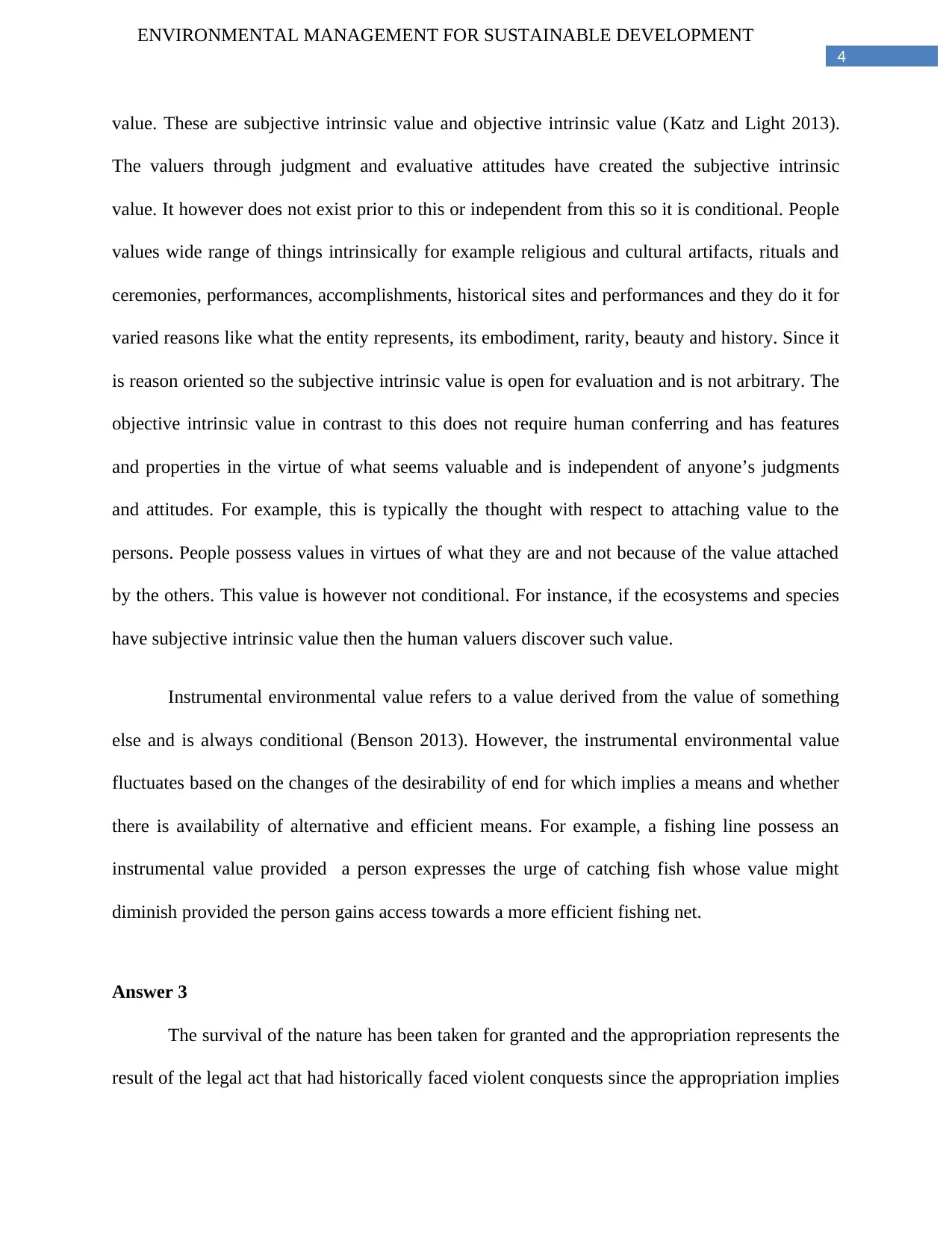
4
ENVIRONMENTAL MANAGEMENT FOR SUSTAINABLE DEVELOPMENT
value. These are subjective intrinsic value and objective intrinsic value (Katz and Light 2013).
The valuers through judgment and evaluative attitudes have created the subjective intrinsic
value. It however does not exist prior to this or independent from this so it is conditional. People
values wide range of things intrinsically for example religious and cultural artifacts, rituals and
ceremonies, performances, accomplishments, historical sites and performances and they do it for
varied reasons like what the entity represents, its embodiment, rarity, beauty and history. Since it
is reason oriented so the subjective intrinsic value is open for evaluation and is not arbitrary. The
objective intrinsic value in contrast to this does not require human conferring and has features
and properties in the virtue of what seems valuable and is independent of anyone’s judgments
and attitudes. For example, this is typically the thought with respect to attaching value to the
persons. People possess values in virtues of what they are and not because of the value attached
by the others. This value is however not conditional. For instance, if the ecosystems and species
have subjective intrinsic value then the human valuers discover such value.
Instrumental environmental value refers to a value derived from the value of something
else and is always conditional (Benson 2013). However, the instrumental environmental value
fluctuates based on the changes of the desirability of end for which implies a means and whether
there is availability of alternative and efficient means. For example, a fishing line possess an
instrumental value provided a person expresses the urge of catching fish whose value might
diminish provided the person gains access towards a more efficient fishing net.
Answer 3
The survival of the nature has been taken for granted and the appropriation represents the
result of the legal act that had historically faced violent conquests since the appropriation implies
ENVIRONMENTAL MANAGEMENT FOR SUSTAINABLE DEVELOPMENT
value. These are subjective intrinsic value and objective intrinsic value (Katz and Light 2013).
The valuers through judgment and evaluative attitudes have created the subjective intrinsic
value. It however does not exist prior to this or independent from this so it is conditional. People
values wide range of things intrinsically for example religious and cultural artifacts, rituals and
ceremonies, performances, accomplishments, historical sites and performances and they do it for
varied reasons like what the entity represents, its embodiment, rarity, beauty and history. Since it
is reason oriented so the subjective intrinsic value is open for evaluation and is not arbitrary. The
objective intrinsic value in contrast to this does not require human conferring and has features
and properties in the virtue of what seems valuable and is independent of anyone’s judgments
and attitudes. For example, this is typically the thought with respect to attaching value to the
persons. People possess values in virtues of what they are and not because of the value attached
by the others. This value is however not conditional. For instance, if the ecosystems and species
have subjective intrinsic value then the human valuers discover such value.
Instrumental environmental value refers to a value derived from the value of something
else and is always conditional (Benson 2013). However, the instrumental environmental value
fluctuates based on the changes of the desirability of end for which implies a means and whether
there is availability of alternative and efficient means. For example, a fishing line possess an
instrumental value provided a person expresses the urge of catching fish whose value might
diminish provided the person gains access towards a more efficient fishing net.
Answer 3
The survival of the nature has been taken for granted and the appropriation represents the
result of the legal act that had historically faced violent conquests since the appropriation implies
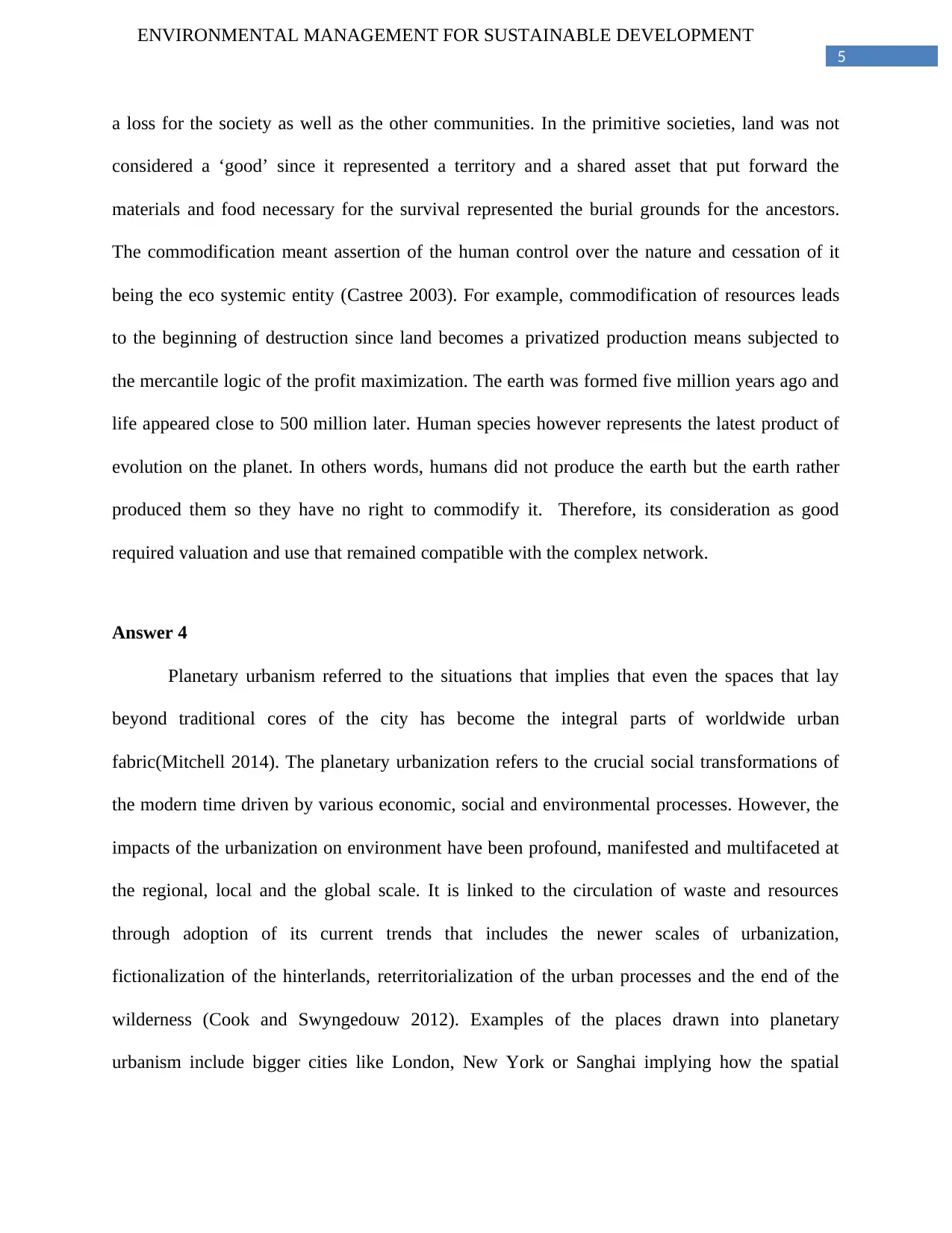
5
ENVIRONMENTAL MANAGEMENT FOR SUSTAINABLE DEVELOPMENT
a loss for the society as well as the other communities. In the primitive societies, land was not
considered a ‘good’ since it represented a territory and a shared asset that put forward the
materials and food necessary for the survival represented the burial grounds for the ancestors.
The commodification meant assertion of the human control over the nature and cessation of it
being the eco systemic entity (Castree 2003). For example, commodification of resources leads
to the beginning of destruction since land becomes a privatized production means subjected to
the mercantile logic of the profit maximization. The earth was formed five million years ago and
life appeared close to 500 million later. Human species however represents the latest product of
evolution on the planet. In others words, humans did not produce the earth but the earth rather
produced them so they have no right to commodify it. Therefore, its consideration as good
required valuation and use that remained compatible with the complex network.
Answer 4
Planetary urbanism referred to the situations that implies that even the spaces that lay
beyond traditional cores of the city has become the integral parts of worldwide urban
fabric(Mitchell 2014). The planetary urbanization refers to the crucial social transformations of
the modern time driven by various economic, social and environmental processes. However, the
impacts of the urbanization on environment have been profound, manifested and multifaceted at
the regional, local and the global scale. It is linked to the circulation of waste and resources
through adoption of its current trends that includes the newer scales of urbanization,
fictionalization of the hinterlands, reterritorialization of the urban processes and the end of the
wilderness (Cook and Swyngedouw 2012). Examples of the places drawn into planetary
urbanism include bigger cities like London, New York or Sanghai implying how the spatial
ENVIRONMENTAL MANAGEMENT FOR SUSTAINABLE DEVELOPMENT
a loss for the society as well as the other communities. In the primitive societies, land was not
considered a ‘good’ since it represented a territory and a shared asset that put forward the
materials and food necessary for the survival represented the burial grounds for the ancestors.
The commodification meant assertion of the human control over the nature and cessation of it
being the eco systemic entity (Castree 2003). For example, commodification of resources leads
to the beginning of destruction since land becomes a privatized production means subjected to
the mercantile logic of the profit maximization. The earth was formed five million years ago and
life appeared close to 500 million later. Human species however represents the latest product of
evolution on the planet. In others words, humans did not produce the earth but the earth rather
produced them so they have no right to commodify it. Therefore, its consideration as good
required valuation and use that remained compatible with the complex network.
Answer 4
Planetary urbanism referred to the situations that implies that even the spaces that lay
beyond traditional cores of the city has become the integral parts of worldwide urban
fabric(Mitchell 2014). The planetary urbanization refers to the crucial social transformations of
the modern time driven by various economic, social and environmental processes. However, the
impacts of the urbanization on environment have been profound, manifested and multifaceted at
the regional, local and the global scale. It is linked to the circulation of waste and resources
through adoption of its current trends that includes the newer scales of urbanization,
fictionalization of the hinterlands, reterritorialization of the urban processes and the end of the
wilderness (Cook and Swyngedouw 2012). Examples of the places drawn into planetary
urbanism include bigger cities like London, New York or Sanghai implying how the spatial
⊘ This is a preview!⊘
Do you want full access?
Subscribe today to unlock all pages.

Trusted by 1+ million students worldwide
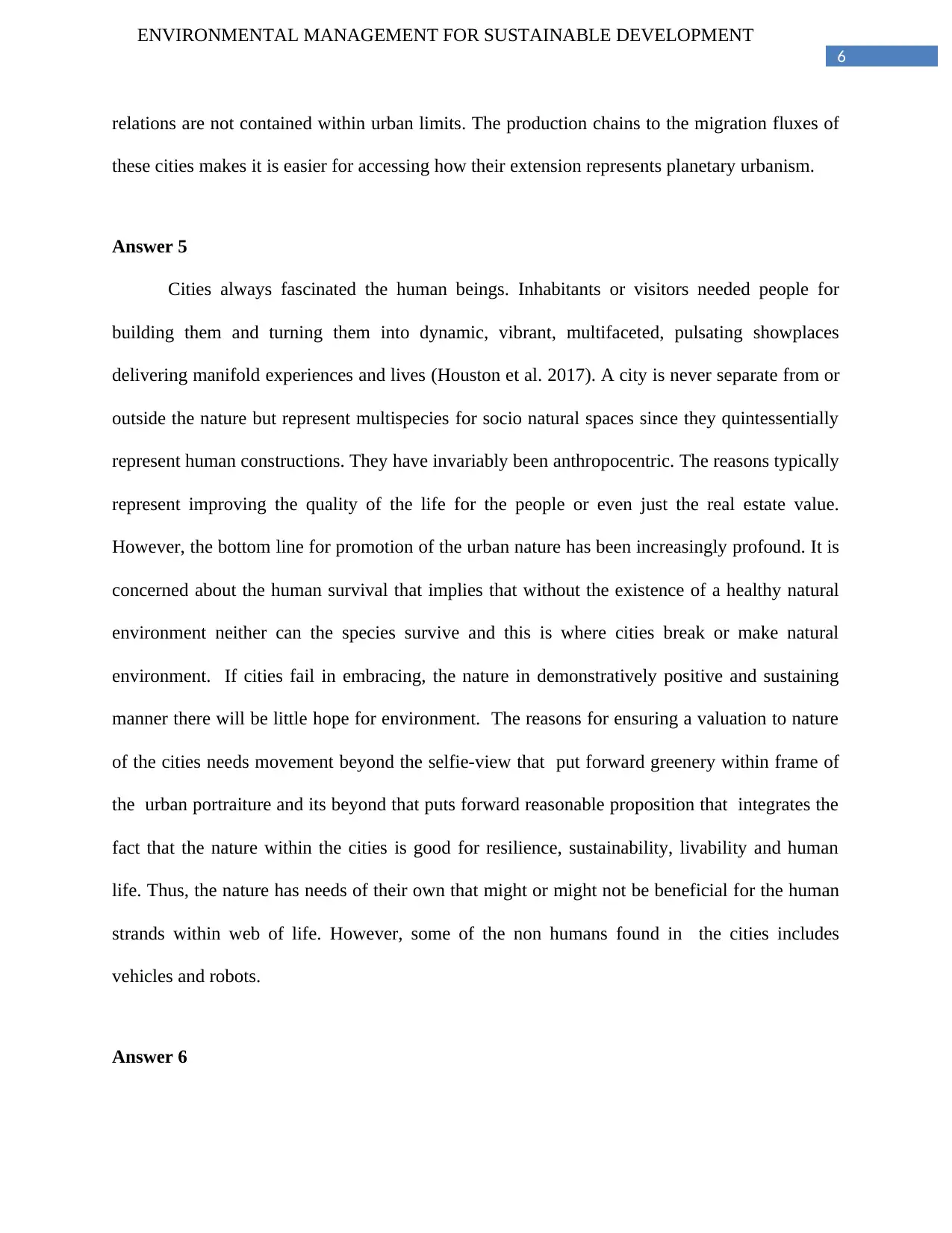
6
ENVIRONMENTAL MANAGEMENT FOR SUSTAINABLE DEVELOPMENT
relations are not contained within urban limits. The production chains to the migration fluxes of
these cities makes it is easier for accessing how their extension represents planetary urbanism.
Answer 5
Cities always fascinated the human beings. Inhabitants or visitors needed people for
building them and turning them into dynamic, vibrant, multifaceted, pulsating showplaces
delivering manifold experiences and lives (Houston et al. 2017). A city is never separate from or
outside the nature but represent multispecies for socio natural spaces since they quintessentially
represent human constructions. They have invariably been anthropocentric. The reasons typically
represent improving the quality of the life for the people or even just the real estate value.
However, the bottom line for promotion of the urban nature has been increasingly profound. It is
concerned about the human survival that implies that without the existence of a healthy natural
environment neither can the species survive and this is where cities break or make natural
environment. If cities fail in embracing, the nature in demonstratively positive and sustaining
manner there will be little hope for environment. The reasons for ensuring a valuation to nature
of the cities needs movement beyond the selfie-view that put forward greenery within frame of
the urban portraiture and its beyond that puts forward reasonable proposition that integrates the
fact that the nature within the cities is good for resilience, sustainability, livability and human
life. Thus, the nature has needs of their own that might or might not be beneficial for the human
strands within web of life. However, some of the non humans found in the cities includes
vehicles and robots.
Answer 6
ENVIRONMENTAL MANAGEMENT FOR SUSTAINABLE DEVELOPMENT
relations are not contained within urban limits. The production chains to the migration fluxes of
these cities makes it is easier for accessing how their extension represents planetary urbanism.
Answer 5
Cities always fascinated the human beings. Inhabitants or visitors needed people for
building them and turning them into dynamic, vibrant, multifaceted, pulsating showplaces
delivering manifold experiences and lives (Houston et al. 2017). A city is never separate from or
outside the nature but represent multispecies for socio natural spaces since they quintessentially
represent human constructions. They have invariably been anthropocentric. The reasons typically
represent improving the quality of the life for the people or even just the real estate value.
However, the bottom line for promotion of the urban nature has been increasingly profound. It is
concerned about the human survival that implies that without the existence of a healthy natural
environment neither can the species survive and this is where cities break or make natural
environment. If cities fail in embracing, the nature in demonstratively positive and sustaining
manner there will be little hope for environment. The reasons for ensuring a valuation to nature
of the cities needs movement beyond the selfie-view that put forward greenery within frame of
the urban portraiture and its beyond that puts forward reasonable proposition that integrates the
fact that the nature within the cities is good for resilience, sustainability, livability and human
life. Thus, the nature has needs of their own that might or might not be beneficial for the human
strands within web of life. However, some of the non humans found in the cities includes
vehicles and robots.
Answer 6
Paraphrase This Document
Need a fresh take? Get an instant paraphrase of this document with our AI Paraphraser
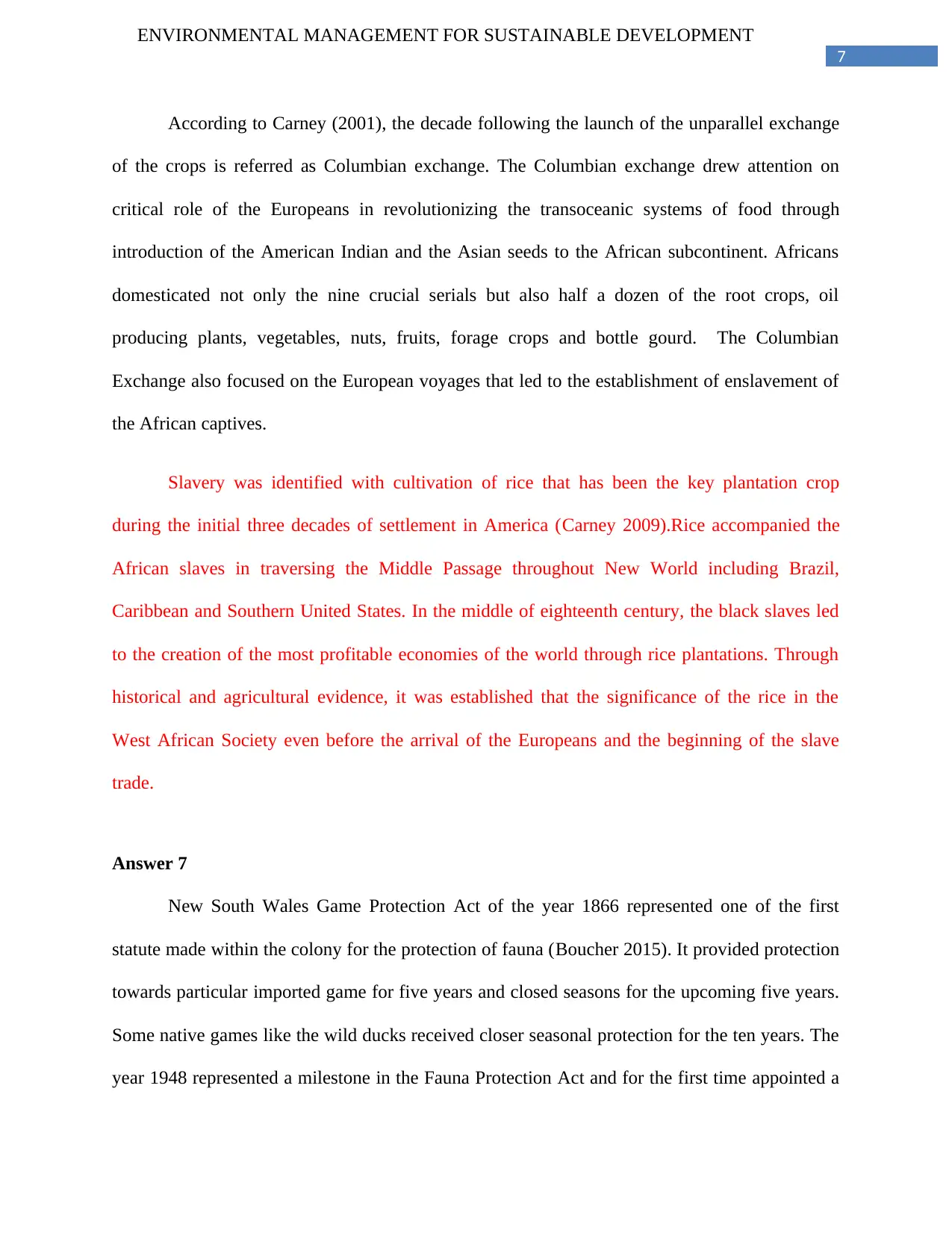
7
ENVIRONMENTAL MANAGEMENT FOR SUSTAINABLE DEVELOPMENT
According to Carney (2001), the decade following the launch of the unparallel exchange
of the crops is referred as Columbian exchange. The Columbian exchange drew attention on
critical role of the Europeans in revolutionizing the transoceanic systems of food through
introduction of the American Indian and the Asian seeds to the African subcontinent. Africans
domesticated not only the nine crucial serials but also half a dozen of the root crops, oil
producing plants, vegetables, nuts, fruits, forage crops and bottle gourd. The Columbian
Exchange also focused on the European voyages that led to the establishment of enslavement of
the African captives.
Slavery was identified with cultivation of rice that has been the key plantation crop
during the initial three decades of settlement in America (Carney 2009).Rice accompanied the
African slaves in traversing the Middle Passage throughout New World including Brazil,
Caribbean and Southern United States. In the middle of eighteenth century, the black slaves led
to the creation of the most profitable economies of the world through rice plantations. Through
historical and agricultural evidence, it was established that the significance of the rice in the
West African Society even before the arrival of the Europeans and the beginning of the slave
trade.
Answer 7
New South Wales Game Protection Act of the year 1866 represented one of the first
statute made within the colony for the protection of fauna (Boucher 2015). It provided protection
towards particular imported game for five years and closed seasons for the upcoming five years.
Some native games like the wild ducks received closer seasonal protection for the ten years. The
year 1948 represented a milestone in the Fauna Protection Act and for the first time appointed a
ENVIRONMENTAL MANAGEMENT FOR SUSTAINABLE DEVELOPMENT
According to Carney (2001), the decade following the launch of the unparallel exchange
of the crops is referred as Columbian exchange. The Columbian exchange drew attention on
critical role of the Europeans in revolutionizing the transoceanic systems of food through
introduction of the American Indian and the Asian seeds to the African subcontinent. Africans
domesticated not only the nine crucial serials but also half a dozen of the root crops, oil
producing plants, vegetables, nuts, fruits, forage crops and bottle gourd. The Columbian
Exchange also focused on the European voyages that led to the establishment of enslavement of
the African captives.
Slavery was identified with cultivation of rice that has been the key plantation crop
during the initial three decades of settlement in America (Carney 2009).Rice accompanied the
African slaves in traversing the Middle Passage throughout New World including Brazil,
Caribbean and Southern United States. In the middle of eighteenth century, the black slaves led
to the creation of the most profitable economies of the world through rice plantations. Through
historical and agricultural evidence, it was established that the significance of the rice in the
West African Society even before the arrival of the Europeans and the beginning of the slave
trade.
Answer 7
New South Wales Game Protection Act of the year 1866 represented one of the first
statute made within the colony for the protection of fauna (Boucher 2015). It provided protection
towards particular imported game for five years and closed seasons for the upcoming five years.
Some native games like the wild ducks received closer seasonal protection for the ten years. The
year 1948 represented a milestone in the Fauna Protection Act and for the first time appointed a
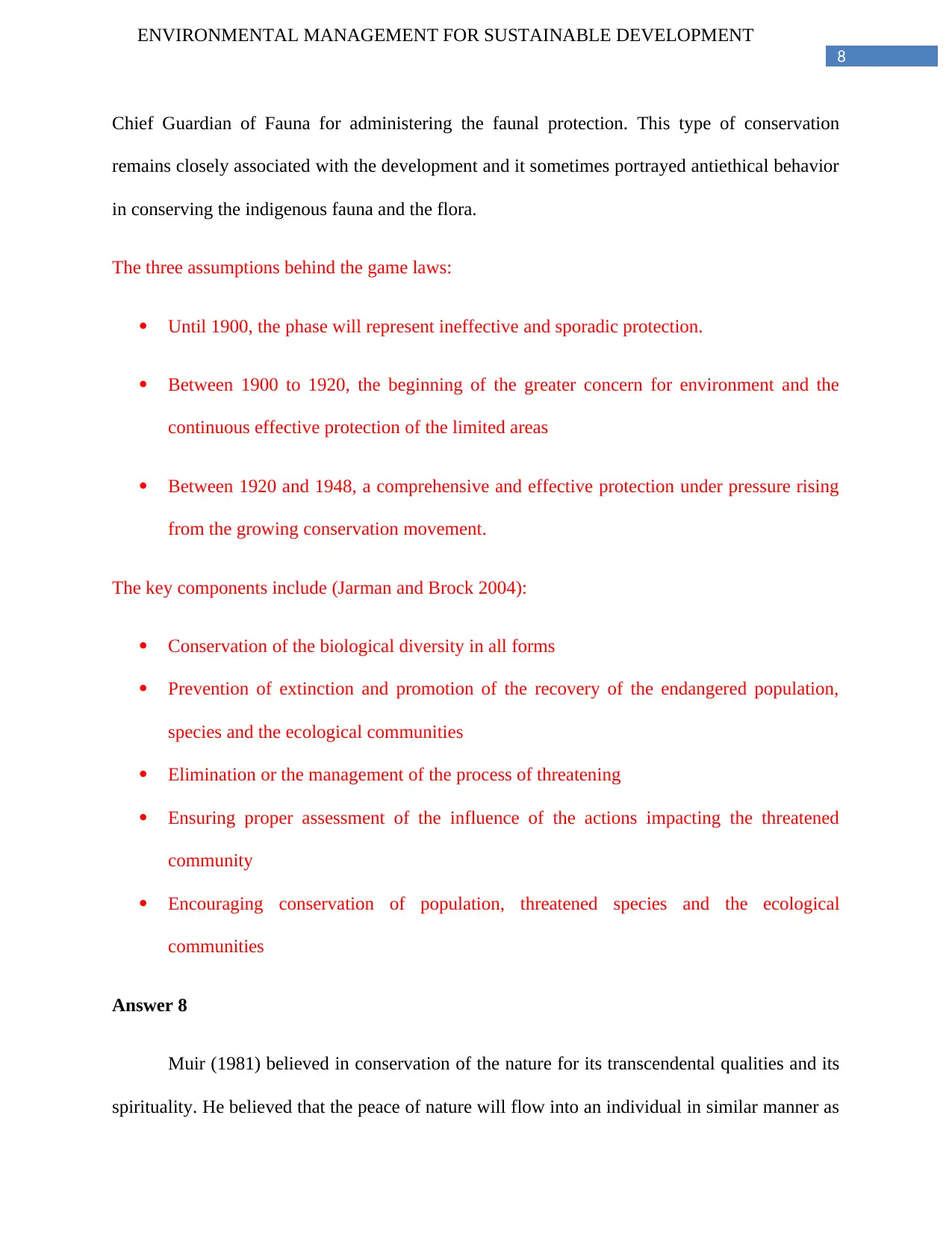
8
ENVIRONMENTAL MANAGEMENT FOR SUSTAINABLE DEVELOPMENT
Chief Guardian of Fauna for administering the faunal protection. This type of conservation
remains closely associated with the development and it sometimes portrayed antiethical behavior
in conserving the indigenous fauna and the flora.
The three assumptions behind the game laws:
Until 1900, the phase will represent ineffective and sporadic protection.
Between 1900 to 1920, the beginning of the greater concern for environment and the
continuous effective protection of the limited areas
Between 1920 and 1948, a comprehensive and effective protection under pressure rising
from the growing conservation movement.
The key components include (Jarman and Brock 2004):
Conservation of the biological diversity in all forms
Prevention of extinction and promotion of the recovery of the endangered population,
species and the ecological communities
Elimination or the management of the process of threatening
Ensuring proper assessment of the influence of the actions impacting the threatened
community
Encouraging conservation of population, threatened species and the ecological
communities
Answer 8
Muir (1981) believed in conservation of the nature for its transcendental qualities and its
spirituality. He believed that the peace of nature will flow into an individual in similar manner as
ENVIRONMENTAL MANAGEMENT FOR SUSTAINABLE DEVELOPMENT
Chief Guardian of Fauna for administering the faunal protection. This type of conservation
remains closely associated with the development and it sometimes portrayed antiethical behavior
in conserving the indigenous fauna and the flora.
The three assumptions behind the game laws:
Until 1900, the phase will represent ineffective and sporadic protection.
Between 1900 to 1920, the beginning of the greater concern for environment and the
continuous effective protection of the limited areas
Between 1920 and 1948, a comprehensive and effective protection under pressure rising
from the growing conservation movement.
The key components include (Jarman and Brock 2004):
Conservation of the biological diversity in all forms
Prevention of extinction and promotion of the recovery of the endangered population,
species and the ecological communities
Elimination or the management of the process of threatening
Ensuring proper assessment of the influence of the actions impacting the threatened
community
Encouraging conservation of population, threatened species and the ecological
communities
Answer 8
Muir (1981) believed in conservation of the nature for its transcendental qualities and its
spirituality. He believed that the peace of nature will flow into an individual in similar manner as
⊘ This is a preview!⊘
Do you want full access?
Subscribe today to unlock all pages.

Trusted by 1+ million students worldwide
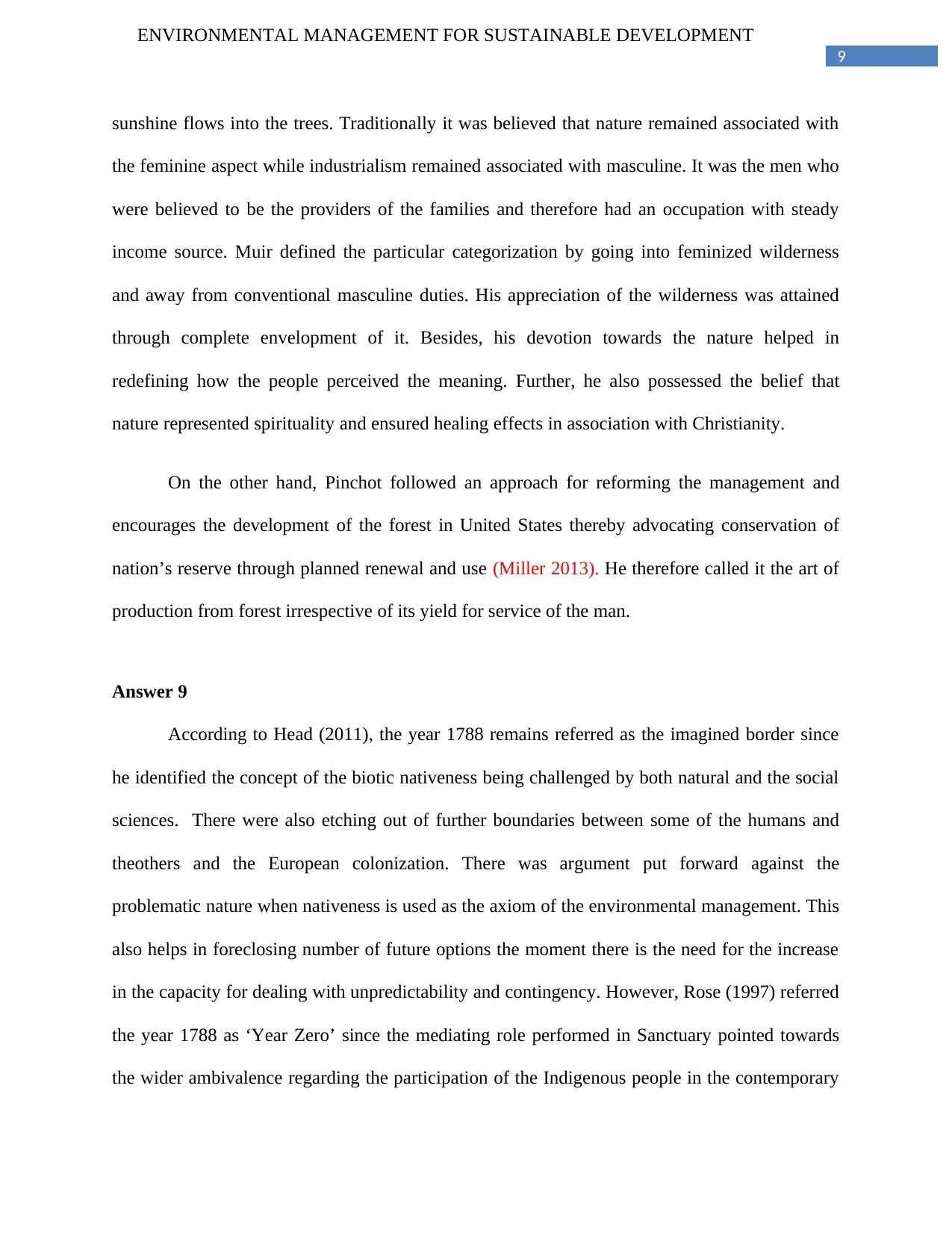
9
ENVIRONMENTAL MANAGEMENT FOR SUSTAINABLE DEVELOPMENT
sunshine flows into the trees. Traditionally it was believed that nature remained associated with
the feminine aspect while industrialism remained associated with masculine. It was the men who
were believed to be the providers of the families and therefore had an occupation with steady
income source. Muir defined the particular categorization by going into feminized wilderness
and away from conventional masculine duties. His appreciation of the wilderness was attained
through complete envelopment of it. Besides, his devotion towards the nature helped in
redefining how the people perceived the meaning. Further, he also possessed the belief that
nature represented spirituality and ensured healing effects in association with Christianity.
On the other hand, Pinchot followed an approach for reforming the management and
encourages the development of the forest in United States thereby advocating conservation of
nation’s reserve through planned renewal and use (Miller 2013). He therefore called it the art of
production from forest irrespective of its yield for service of the man.
Answer 9
According to Head (2011), the year 1788 remains referred as the imagined border since
he identified the concept of the biotic nativeness being challenged by both natural and the social
sciences. There were also etching out of further boundaries between some of the humans and
theothers and the European colonization. There was argument put forward against the
problematic nature when nativeness is used as the axiom of the environmental management. This
also helps in foreclosing number of future options the moment there is the need for the increase
in the capacity for dealing with unpredictability and contingency. However, Rose (1997) referred
the year 1788 as ‘Year Zero’ since the mediating role performed in Sanctuary pointed towards
the wider ambivalence regarding the participation of the Indigenous people in the contemporary
ENVIRONMENTAL MANAGEMENT FOR SUSTAINABLE DEVELOPMENT
sunshine flows into the trees. Traditionally it was believed that nature remained associated with
the feminine aspect while industrialism remained associated with masculine. It was the men who
were believed to be the providers of the families and therefore had an occupation with steady
income source. Muir defined the particular categorization by going into feminized wilderness
and away from conventional masculine duties. His appreciation of the wilderness was attained
through complete envelopment of it. Besides, his devotion towards the nature helped in
redefining how the people perceived the meaning. Further, he also possessed the belief that
nature represented spirituality and ensured healing effects in association with Christianity.
On the other hand, Pinchot followed an approach for reforming the management and
encourages the development of the forest in United States thereby advocating conservation of
nation’s reserve through planned renewal and use (Miller 2013). He therefore called it the art of
production from forest irrespective of its yield for service of the man.
Answer 9
According to Head (2011), the year 1788 remains referred as the imagined border since
he identified the concept of the biotic nativeness being challenged by both natural and the social
sciences. There were also etching out of further boundaries between some of the humans and
theothers and the European colonization. There was argument put forward against the
problematic nature when nativeness is used as the axiom of the environmental management. This
also helps in foreclosing number of future options the moment there is the need for the increase
in the capacity for dealing with unpredictability and contingency. However, Rose (1997) referred
the year 1788 as ‘Year Zero’ since the mediating role performed in Sanctuary pointed towards
the wider ambivalence regarding the participation of the Indigenous people in the contemporary
Paraphrase This Document
Need a fresh take? Get an instant paraphrase of this document with our AI Paraphraser
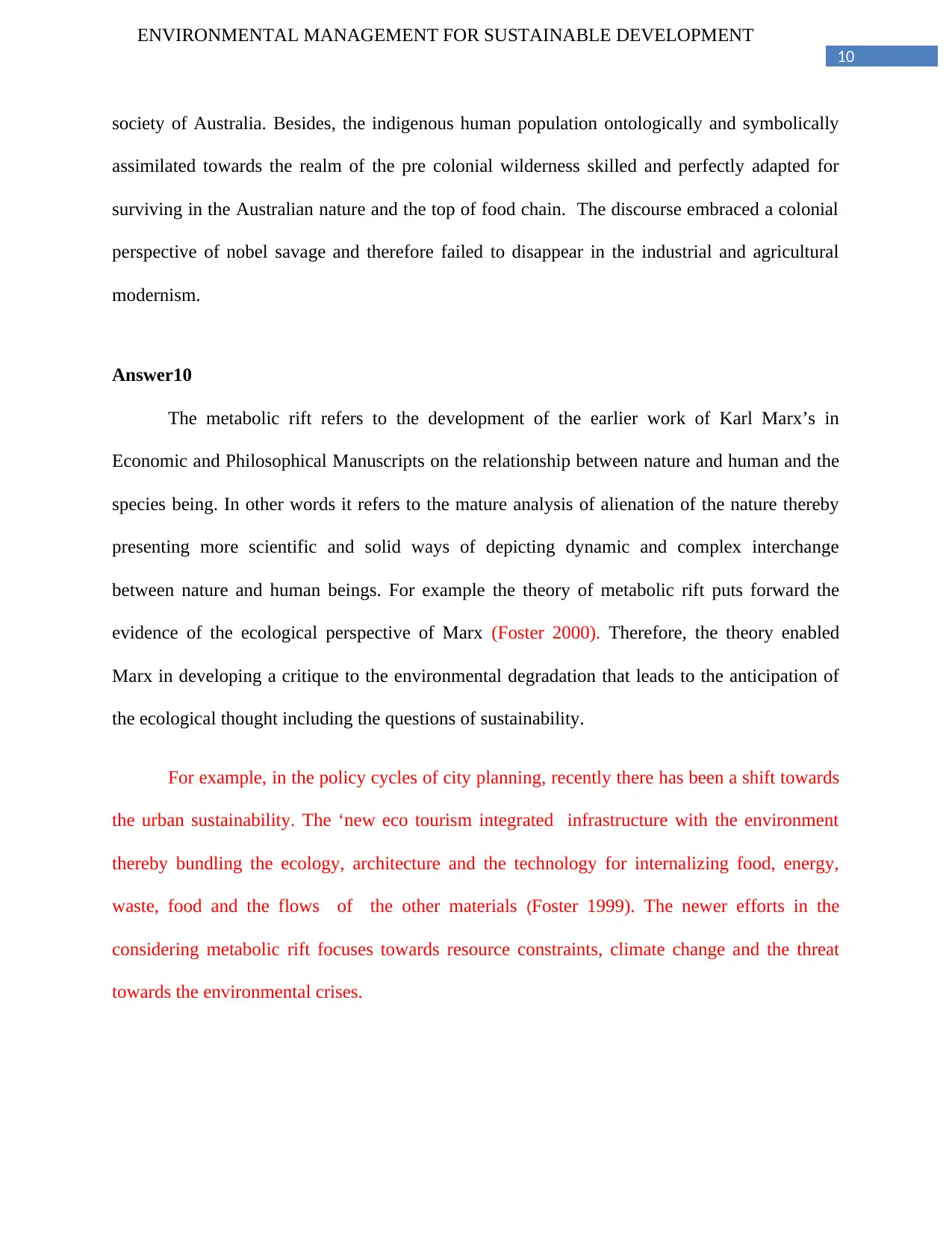
10
ENVIRONMENTAL MANAGEMENT FOR SUSTAINABLE DEVELOPMENT
society of Australia. Besides, the indigenous human population ontologically and symbolically
assimilated towards the realm of the pre colonial wilderness skilled and perfectly adapted for
surviving in the Australian nature and the top of food chain. The discourse embraced a colonial
perspective of nobel savage and therefore failed to disappear in the industrial and agricultural
modernism.
Answer10
The metabolic rift refers to the development of the earlier work of Karl Marx’s in
Economic and Philosophical Manuscripts on the relationship between nature and human and the
species being. In other words it refers to the mature analysis of alienation of the nature thereby
presenting more scientific and solid ways of depicting dynamic and complex interchange
between nature and human beings. For example the theory of metabolic rift puts forward the
evidence of the ecological perspective of Marx (Foster 2000). Therefore, the theory enabled
Marx in developing a critique to the environmental degradation that leads to the anticipation of
the ecological thought including the questions of sustainability.
For example, in the policy cycles of city planning, recently there has been a shift towards
the urban sustainability. The ‘new eco tourism integrated infrastructure with the environment
thereby bundling the ecology, architecture and the technology for internalizing food, energy,
waste, food and the flows of the other materials (Foster 1999). The newer efforts in the
considering metabolic rift focuses towards resource constraints, climate change and the threat
towards the environmental crises.
ENVIRONMENTAL MANAGEMENT FOR SUSTAINABLE DEVELOPMENT
society of Australia. Besides, the indigenous human population ontologically and symbolically
assimilated towards the realm of the pre colonial wilderness skilled and perfectly adapted for
surviving in the Australian nature and the top of food chain. The discourse embraced a colonial
perspective of nobel savage and therefore failed to disappear in the industrial and agricultural
modernism.
Answer10
The metabolic rift refers to the development of the earlier work of Karl Marx’s in
Economic and Philosophical Manuscripts on the relationship between nature and human and the
species being. In other words it refers to the mature analysis of alienation of the nature thereby
presenting more scientific and solid ways of depicting dynamic and complex interchange
between nature and human beings. For example the theory of metabolic rift puts forward the
evidence of the ecological perspective of Marx (Foster 2000). Therefore, the theory enabled
Marx in developing a critique to the environmental degradation that leads to the anticipation of
the ecological thought including the questions of sustainability.
For example, in the policy cycles of city planning, recently there has been a shift towards
the urban sustainability. The ‘new eco tourism integrated infrastructure with the environment
thereby bundling the ecology, architecture and the technology for internalizing food, energy,
waste, food and the flows of the other materials (Foster 1999). The newer efforts in the
considering metabolic rift focuses towards resource constraints, climate change and the threat
towards the environmental crises.
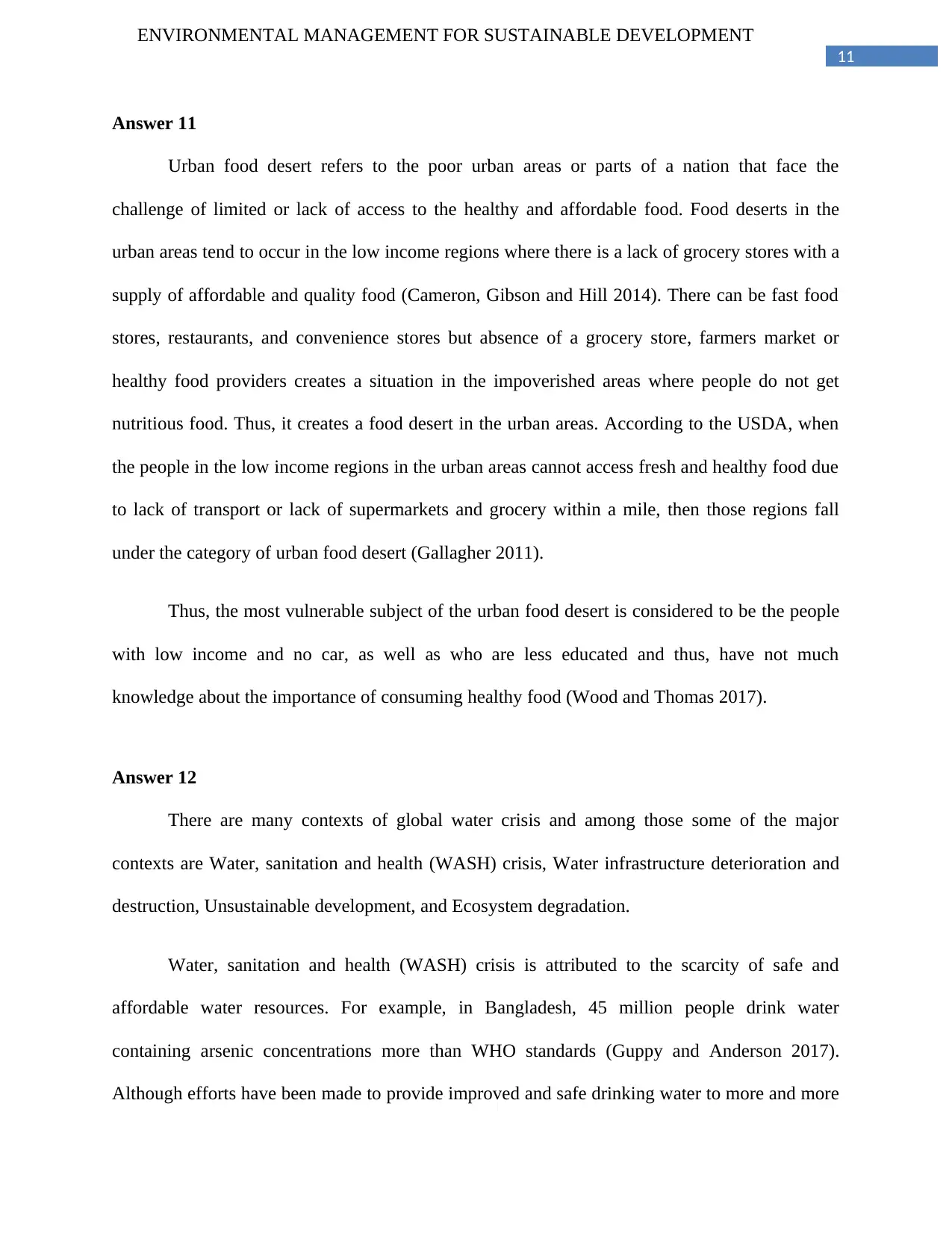
11
ENVIRONMENTAL MANAGEMENT FOR SUSTAINABLE DEVELOPMENT
Answer 11
Urban food desert refers to the poor urban areas or parts of a nation that face the
challenge of limited or lack of access to the healthy and affordable food. Food deserts in the
urban areas tend to occur in the low income regions where there is a lack of grocery stores with a
supply of affordable and quality food (Cameron, Gibson and Hill 2014). There can be fast food
stores, restaurants, and convenience stores but absence of a grocery store, farmers market or
healthy food providers creates a situation in the impoverished areas where people do not get
nutritious food. Thus, it creates a food desert in the urban areas. According to the USDA, when
the people in the low income regions in the urban areas cannot access fresh and healthy food due
to lack of transport or lack of supermarkets and grocery within a mile, then those regions fall
under the category of urban food desert (Gallagher 2011).
Thus, the most vulnerable subject of the urban food desert is considered to be the people
with low income and no car, as well as who are less educated and thus, have not much
knowledge about the importance of consuming healthy food (Wood and Thomas 2017).
Answer 12
There are many contexts of global water crisis and among those some of the major
contexts are Water, sanitation and health (WASH) crisis, Water infrastructure deterioration and
destruction, Unsustainable development, and Ecosystem degradation.
Water, sanitation and health (WASH) crisis is attributed to the scarcity of safe and
affordable water resources. For example, in Bangladesh, 45 million people drink water
containing arsenic concentrations more than WHO standards (Guppy and Anderson 2017).
Although efforts have been made to provide improved and safe drinking water to more and more
ENVIRONMENTAL MANAGEMENT FOR SUSTAINABLE DEVELOPMENT
Answer 11
Urban food desert refers to the poor urban areas or parts of a nation that face the
challenge of limited or lack of access to the healthy and affordable food. Food deserts in the
urban areas tend to occur in the low income regions where there is a lack of grocery stores with a
supply of affordable and quality food (Cameron, Gibson and Hill 2014). There can be fast food
stores, restaurants, and convenience stores but absence of a grocery store, farmers market or
healthy food providers creates a situation in the impoverished areas where people do not get
nutritious food. Thus, it creates a food desert in the urban areas. According to the USDA, when
the people in the low income regions in the urban areas cannot access fresh and healthy food due
to lack of transport or lack of supermarkets and grocery within a mile, then those regions fall
under the category of urban food desert (Gallagher 2011).
Thus, the most vulnerable subject of the urban food desert is considered to be the people
with low income and no car, as well as who are less educated and thus, have not much
knowledge about the importance of consuming healthy food (Wood and Thomas 2017).
Answer 12
There are many contexts of global water crisis and among those some of the major
contexts are Water, sanitation and health (WASH) crisis, Water infrastructure deterioration and
destruction, Unsustainable development, and Ecosystem degradation.
Water, sanitation and health (WASH) crisis is attributed to the scarcity of safe and
affordable water resources. For example, in Bangladesh, 45 million people drink water
containing arsenic concentrations more than WHO standards (Guppy and Anderson 2017).
Although efforts have been made to provide improved and safe drinking water to more and more
⊘ This is a preview!⊘
Do you want full access?
Subscribe today to unlock all pages.

Trusted by 1+ million students worldwide
1 out of 28
Your All-in-One AI-Powered Toolkit for Academic Success.
+13062052269
info@desklib.com
Available 24*7 on WhatsApp / Email
![[object Object]](/_next/static/media/star-bottom.7253800d.svg)
Unlock your academic potential
Copyright © 2020–2025 A2Z Services. All Rights Reserved. Developed and managed by ZUCOL.